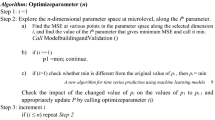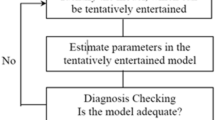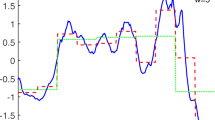Characteristic problems of data collection in the process of fracturing operations are due to high frequency of data collection and complex downhole operating environment. In order to compensate noise and fluctuations in the fracturing data, we propose to apply an online piecewise linear representation method for hydraulic fracturing time series to re-describe the original sequence. First, the unique engineering characteristics of start and stop sanding in fracturing scenarios are combined, integrating the fitting errors to segment the sliding window; second, a mechanism of online optimization of the fitting form is proposed for adjacent fitting line segments with similar trends. When optimization is performed, the degree of optimization is calculated using the trend factor and the vertical distance factor. Finally, the original series is replaced by the fitted line segment. Based on actual fracturing data, we experimentally compare a proposed method with a variety of benchmark methods. The results show that thу developed method can retain important information of the original sequence to the greatest extent while coarse-graining the original sequence. Applying the linear representation method of the fracturing data, the computing time of the upper-level task can be further reduced and the task performance improved.








Similar content being viewed by others
References
Y. Tang, X. Tang, G. Y. Wang, and Q. Zhang, “Summary of hydraulic fracturing technology in shale gas development,” Geol. Bull. China, 30, 393-399 (2011).
A. Sharma, A. Kumar, A. K. Pandey, and R. Singh, Algorithms for Intelligent Systems, Springer, Singapore (2020), pp. 267-284.
T. C. Fu, “A review on time series data mining,” Eng. Appl. Artific. Intell., 24, 164-181 (2011).
J. Paparrizos and M. J. Franklin, “Grail: efficient time-series representation learning,” Proc. VLDB Endowment, 12, 1762-1777 (2019).
R. Rezvani, P. Barnaghi, and S. Enshaeifar, “A new pattern representation method for time-series data,” IEEE Transact. Knowl. Data Eng., 33, 2818-2832 (2019).
X. Liu, Z. Lin, and H. Wang, “Novel online methods for time series segmentation,” IEEE Transact. Knowl. Data Eng., 20, 1616-1626 (2020).
L. Luo and X. Chen, “Integrating piecewise linear representation and weighted support vector machine for stock trading signal prediction,” Appl. Soft Comput., 13, 806-816 (2019).
C. J. Wu, W. S. Zeng, and J. M. Ho, “Optimal segmented linear regression for financial time series segmentation,” International Conference on Data Mining Workshops (ICDMW), Auckland, New Zealand, 7-10 December (2021).
H. S. Wu, F.M. Zhang, and B. Zhong, “Similar pattern matching method for multivariate time series based on two-dimensional singular value decomposition,” J. Electron. Inform. Technol., 36, 847-854. 2014,
H. Mao, F. Zhang, H. Feng, and H. Lv, “Similarity-based pattern querying in multivariate flight data,” Comput. Eng. Appl., 47, 151-155 (2011).
X. Wang, K. Smith, and R. Hyndman, “Characteristic-based clustering for time series data,” Data Min. Knowl. Discov., 13, 335-364 (2006).
R. Agrawal, C. Faloutsos, and A. Swami, “Efficient similarity search in sequence databases,” International Conference on Foundations of Data Organization and Algorithms, Berlin, Germany (1993).
L. Q. Zhan, D. X. Liu, and J. P. Zhang, “Time series subsequence clustering based on wavelet filters,” Comput. Eng. Appl., 43, 4-7 (2007).
J. Lin, E. Keogh, L. Wei, and S. Lonardi, “Experiencing SAX: a novel symbolic representation of time series,” Data Min. Knowl. Discov., 15, 107-144 (2007).
M. G. Baydogan and G. Runger, “Learning a symbolic representation for multivariate time series classification,” Data Min. Knowl. Discov., 29, 400-422 (2015).
E. Keogh, S. Chu, D. Hart, and M. Pazzani, “An online algorithm for segmenting time series,” IEEE International Conference on Data Mining, San Jose, USA (2001).
H. Ren, B. Xu, Y. Wang, C. Yi, C. Huang, X. Kou, and Q. Zhang, “Time-series anomaly detection service at microsoft,” 25th ACM SIGKDD International Conference on Knowledge Discovery & Data Mining, New York, USA (2019).
P. Zhan, C. Sun, Y. Hu, W. Luo, J. Zheng, and X. Li, “Feature-based online representation algorithm for streaming time series similarity search,” Int. J. Pattern Recog. Artific. Intell., 34, 2050010 (2020).
Y. Zhu, D. Wu, and S. Li, “A piecewise linear representation method of time series based on feature points,” International Conference on Knowledge-based and Intelligent Information and Engineering Systems, Vietri sul Mare, Italy, 12-14 September (2007).
C. Ji, S. Liu, C. Yang, L. Wu, L. Pan, and X. Meng, “A piecewise linear representation method based on importance data points for time series data,” IEEE 20th International Conference on Computer Supported Cooperative Work in Design (CSCWD), Nanchang, China, 4-6 May (2016).
K. C. Wee and M. S. M. Zahid, “Cloud computing for ECG analysis using MapReduce,” 4th International Conference on Advanced Computer Science Applications and Technologies (ACSAT), Kuala Lumpur, Malaysia, 8-10 December (2015).
Q. Xie, C. Pang, X. Zhou, X. Zhang, and K. Deng, “Maximum error-bounded piecewise linear representation for online stream approximation,” VLDB J., 23, 915-937 (2014).
Y. Hu, P. Zhan, Y. Xu, J. Zhao, Y. Li, and X. Li, “Temporal representation learning for time series classification,” Neur. Comput. Appl., 33, 3169-3182 (2021).
J. F. Ehmke, S. Meisel, and D. C. Mattfeld, “Floating car based travel times for city logistics,” Transp. Res. C: Emerg. Technol., 21, 338-352 (2012).
D. Alberg, Advanced Methodologies and Technologies in Network Architecture, Mobile Computing, and Data Analytics, IGI Global, USA (2019), pp.46-56.
N. Tatti, “Strongly polynomial efficient approximation scheme for segmentation,” Inform. Proc. Lett., 142, 1-8 (2019).
H. Shatkay and S. B. Zdonik, “Approximate queries and representations for large data sequences,” 12th International Conference on Data Engineering, New Orleans, LA, USA, 26 February.-1 March (1996).
D. Z. Zhou and M. Q. Li, “Time series segmentation based on series importance point,” Comput. Eng., 34, 14-16 (2008).
Author information
Authors and Affiliations
Corresponding author
Additional information
Translated from Khimiya i Tekhnologiya Topliv i Masel, No. 2, pp. 87–93 March– April, 2022.
Rights and permissions
About this article
Cite this article
Deng, D., Li, B. An Online Piecewise Linear Representation Method for Hydraulic Fracturing Time Series. Chem Technol Fuels Oils 58, 391–402 (2022). https://doi.org/10.1007/s10553-022-01396-2
Published:
Issue Date:
DOI: https://doi.org/10.1007/s10553-022-01396-2




